What You Need to Know About Hiking in California
12 Top-Rated Hiking Trails in California
California is a hiker'south paradise, with an incredible variety of landscapes. The nature sites are then sublime that elementary descriptions but hint at their grandeur: the magnificent, glacier-carved valley of Yosemite; a breathtaking, mountainous coastline in Large Sur; the serenely barren Mojave Desert; the royal, snowcapped Mountain Shasta; and a rugged, untamed wilderness in Solstice Canyon.
Several of California'south national parks boast tape-breaking statistics. Yosemite National Park has the longest waterfall in North America, while Mount Whitney in Sequoia National Park has the highest summit in the continental U.s.a., and the tallest trees in the world are establish in the Redwood National and State Parks.
This list of top-rated hikes covers the highlights of California'south nature trails, with a range of moderate to strenuous hikes at famous places like Yosemite and Mount Shasta. For those ready to accept on an farthermost challenge, the listing includes two epic hikes at legendary nature sites, Mount Whitney and the Lost Coast, that should just be attempted by avant-garde hikers.
Find some space in the wilderness with our list of the tiptop hiking trails in California.
Note: Some businesses may be temporarily airtight due to contempo global health and safety bug.
one. Yosemite Falls Trail: A Spectacular Hike to Northward America's Tallest Waterfall
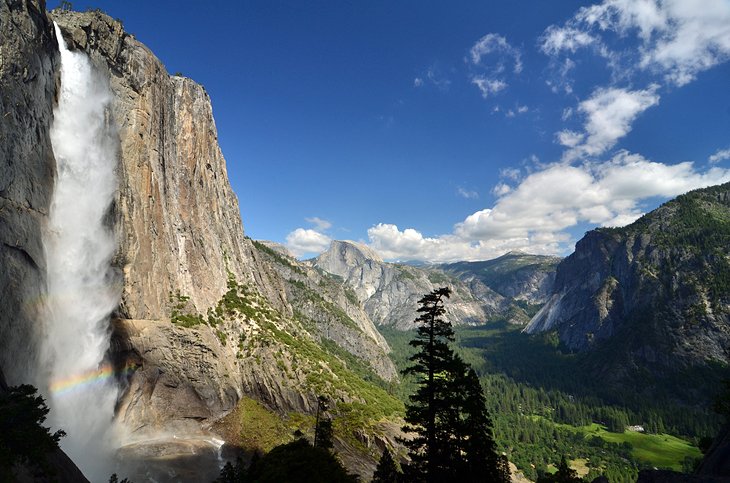
One of the best hikes in Yosemite National Park, this trail provides shut-up views of Yosemite's most spectacular waterfall, too every bit panoramic vistas of the valley floor. The trail includes 2 parts. With both sections combined, the Yosemite Falls Trail is a ix-mile round-trip hike.
The commencement part of the Yosemite Falls Trail is the one-mile department to Columbia Rock, a moderate hike that ascends 1,000 feet through a switchback trail. Views from Columbia Rock sweep across the Yosemite Valley to One-half Dome in the altitude. If you decided not to complete the second part of Yosemite Falls Trails, this section alone is a two-mile round-trip hike that takes about two to three hours.
The second part of the trail upwardly to Yosemite Falls is more hard. This strenuous, seven-mile round-trip hike includes an elevation gain of 2,700 anxiety, up rugged terrain and steep hillside staircases. To consummate this round-trip hike takes some other six to eight hours from Colombia Rock.
The Yosemite Falls Trail is thrillingly close to Yosemite Falls. While climbing the trail, hikers often feel mist from the waterfalls. Subsequently reaching the summit of this challenging trail, hikers are dazzled by expansive vistas of the entire Yosemite Valley.
Best Fourth dimension to Hike to Yosemite Falls: The best fourth dimension to hike the Yosemite Falls Trail is in the spring, when the waterfalls are abundantly flowing. By August, the water levels are lower, and the falls are less impressive.
In summer, brainstorm the hike early on in the solar day because the trail tin exist very hot by apex, and the upper portion is exposed, with no shade past the tardily afternoon.
In leap and fall, consider the length of the circular-trip hike and the time of sunset; exist sure to set out early enough to complete the round-trip in daylight.
Hiking Tips: Wear hiking shoes with good treads because this trail can exist slippery. Bring bottled water; drinking water is not available on the trail.
Prophylactic Tips: Ever stay on the path. Wandering off can pb to dangerous sheer drop-offs near the trail.
Watch out for areas of loose sand and rocky terrain that tin be slippery. Exercise non stray from the trail, some areas pb to dangerous, steep drops.
During winter, ice and snow tin can brand the upper portion of the trail unsafe for hiking. Do not hike the second function of the trail up to the tiptop of Yosemite Falls in freezing or snowy atmospheric condition conditions.
- Read More:
- Top Attractions & Things to Do in Yosemite National Park
two. Mount Shasta
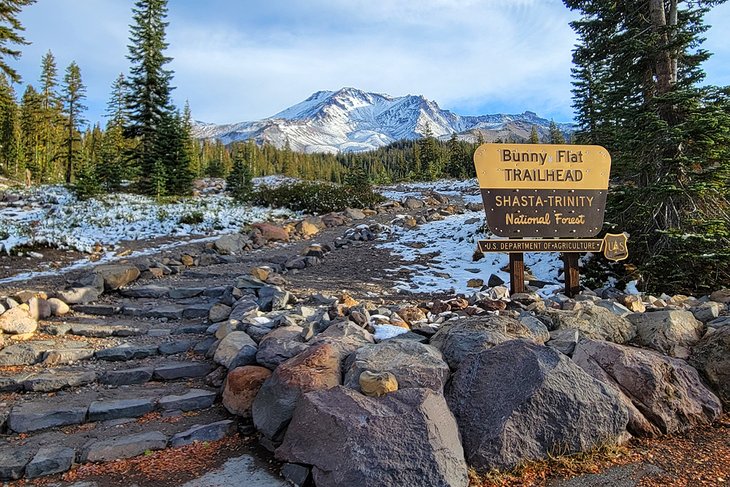
Mountain Shasta
The majestic, snowcapped Mountain Shasta is one of the most inspiring places to hike in California. Many visitors come up to Mount Shasta seeking a spiritual experience in nature. Audacious outdoor enthusiasts come for the challenge of climbing to the mount'due south superlative. Nevertheless, Mount Shasta has plenty of hiking trails that are suitable for the average hiker.
A popular hike on Mount Shasta is the Gray Butte Trail. With a trailhead above vii,000 feet in summit, this moderate, 3.v-mile circular-trip trail gains 750 feet and takes about three hours to complete.
The trail begins at the Panther Meadows Campground parking lot, crosses through the expansive Lower Panther Meadow and continues upwards through a pristine forest of old-growth Cherry-red Fir Trees.
At the fork in the trail, the righthand-side ascends through a stand of fragrant Mountain Hemlock Trees. The trail continues past the Lower Peak to the Upper Peak of Gray Butte, offer splendid panoramic views at several vantage points forth the way.
Hiking Tip: This hike is simply accessible in the summer and early on fall, from tardily June until late October.
iii. McWay Waterfall Trail: The Most Iconic Site in Big Sur
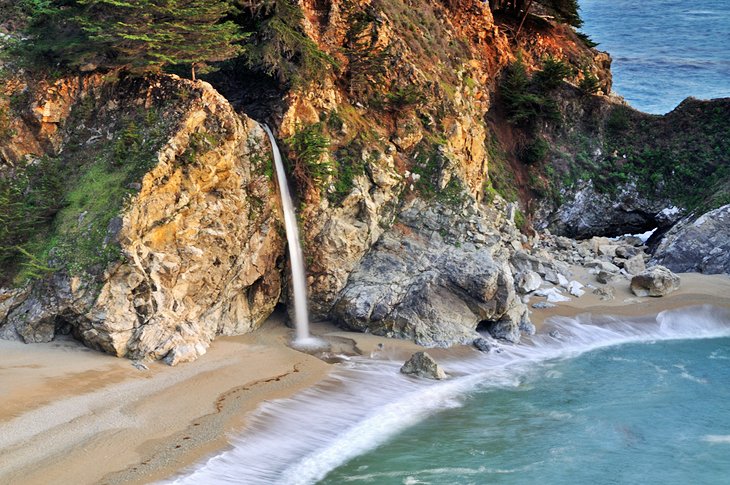
Leading to Big Sur's most frequently photographed sight, this trail is in Julia Pfeiffer Burns State Park. Named afterwards the female pioneer who owned a ranch in Big Sur country in the early on 1900s, the park stretches along the mountainous Big Sur coastline, with its forested 3,000-foot ridges that drop off dramatically into the Pacific Ocean. Julia Pfeiffer Burns State Park has 2 walk-in campsites, which are among Big Sur's best campgrounds.
The McWay Waterfall Trail is a very short hike to a picket of the McWay Waterfall. Despite the grandeur of the scenery, this trail is surprisingly easy and brusk. More than of a stroll than a hike, the 0.6-mile round-trip trail takes merely about thirty minutes to complete.
The sentinel provides a stunning perspective of the fourscore-pes McWay Waterfall, which drops from a sheer granite cliff onto a sandy beach in the secluded cove below. Hikers may spend more time admiring the waterfall and bounding main views than actually hiking. The overlook is likewise a practiced spot to view whales during the migration season.
Safety Notes: In that location is no access to the beach from the McWay Waterfall Trail. Attempting to hike down to the beach is extremely dangerous and strictly prohibited.
Stay away from the edges of the trail. Signs posted warn of danger due to unstable cliffs.
Accommodation: Best Hotels in Big Sur, CA
4. Ocean Lion Bespeak Trail in Bespeak Lobos
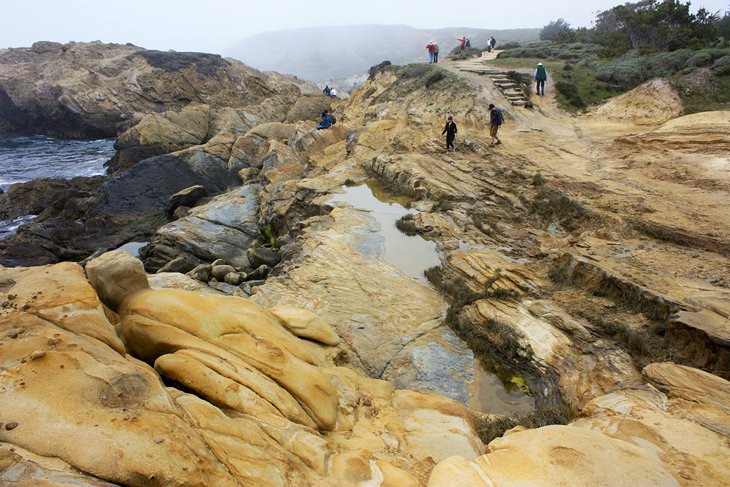
The Sea Lion Signal Trail delights nature lovers who appreciate marine wild fauna and ocean views. A short and easy hike, the 0.6-mile loop trail is an especially scenic portion of Betoken Lobos State Reserve in Carmel. The charming seaside village of Carmel is a one-hour drive south of Santa Cruz, some other expanse that has gorgeous hiking trails.
Winding around peaceful coves and rocky ocean bluffs that meet with crashing waves, the Sea Lion Point Trail gives hikers a risk to spot barking sea lions on offshore rocks. The trail also passes past Headland Cove and Sea Lion Cove, quiet coves where seals swim, and body of water otters bask in the protected waters.
To get a closer view of the animals, hikers may walk down a staircase that provides access to the coves. If taking the steps downward to the coves, be conscientious to stay away from the edges and watch out for unexpected waves.
5. James Irvine Trail at Prairie Creek Redwoods Country Park
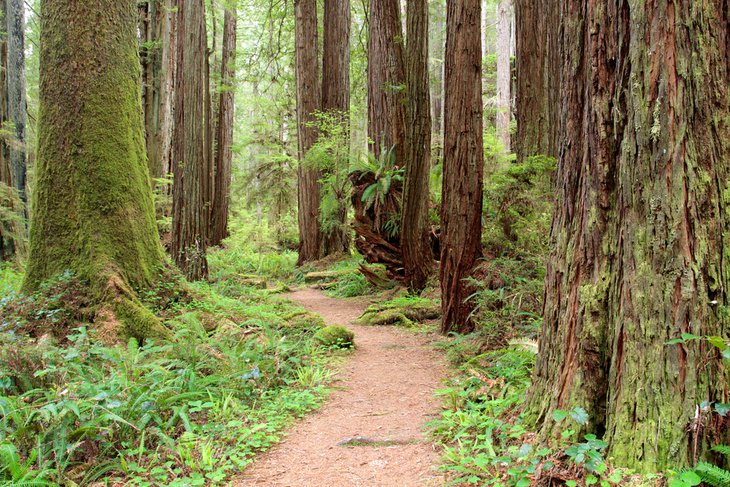
Hikers can adore some of the word's tallest and oldest trees at Prairie Creek Redwoods State Park, which is one of the jointly managed Redwood National and State Parks in northern California. This grove of old-growth coastal redwood copse descends from a primeval forest that existed when dinosaurs roamed the Earth.
The best of the Redwood National and State Parks hikes, the 10-mile round-trip James Irvine Trail in Prairie Creek Redwoods State Park offers varied and majestic scenery. This moderate trail winds through dense redwood wood, forth hillsides and ridges and through valleys.
Even if you do not complete the unabridged hike, it is well worth going about a mile or and so out and back. That way, you lot tin at least experience the magnificence of towering redwoods and the refreshing feel of their leafy canopies shading the path.
At the end of the James Irvine Trail, the path connects with the short (0.half-dozen-mile) Fern Canyon Trail, which leads to the beach. Vii different types of ferns blanket the coulee. The dense vegetation absorbs sounds, lending a sense of peacefulness. It'due south completely tranquillity hither, except for the chirping of birds, the rushing (or trickle) of a freshwater creek, and body of water waves crashing in the distance.
Fern Coulee is so remarkable that it was chosen by Hollywood directors as a backdrop for scenes in the Jurassic Park film. In fact, relatives of today's living coastal redwoods existed 160 1000000 years agone, during the Jurassic Era.
6. Redwood National Park: Male child Lookout man Tree Trail
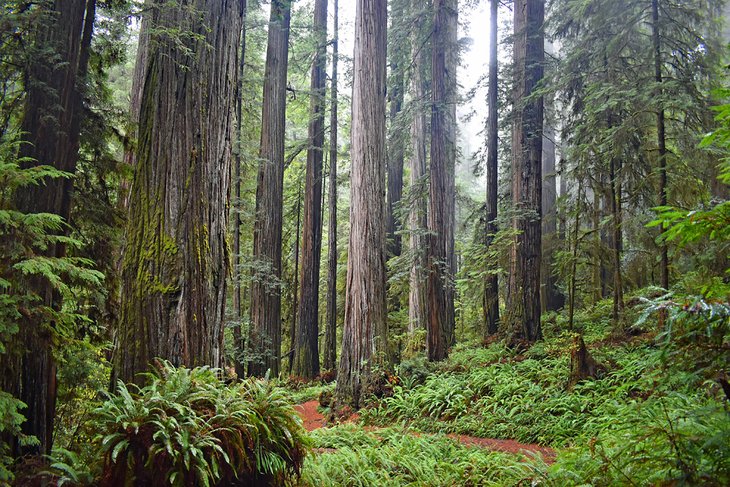
Redwood National Park: Boy Picket Tree Trail | Miguel Vieira / photo modified
In the north of California near the Oregon border, the Jedediah Smith Redwoods State Park is one of the Redwood National and Land Parks. The hiking areas of Jedediah Smith Redwoods State Park give visitors a wonderful feeling of being far removed from the urban environment.
A moderate trail through an old-growth redwood forest, the five.6-mile circular-trip Male child Scout Tree Trail is among the best hikes in the Redwood National and State Parks. The trail is by and large like shooting fish in a barrel, except for some areas of switchback turns and steep grades. Allow virtually a half solar day to hike the trail and take your fourth dimension admiring the dense canopy of giant trees.
Nigh 2.5 miles from the trailhead, a spur trail leads upward to a 2,000-year-former double redwood tree, named the Male child Scout Tree because it was discovered by a Boy Scout troop leader. The trail concludes at the picturesque Fern Falls earlier hikers loop back to the trailhead.
vii. Lost Palms Oasis and 49 Palms Trails at Joshua Tree National Park
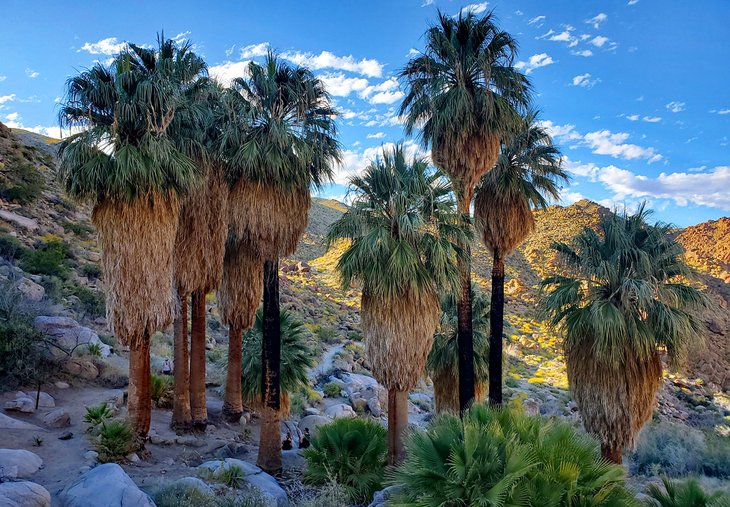
Lost Palms Oasis and 49 Palms Trails at Joshua Tree National Park | Miguel Vieira / photo modified
Joshua National Park is located in the rugged and arid Mojave Desert, a distinct area of the California desert region. Although about famous for the Joshua tree, this national park too has several interesting trails that travel through palm oases.
The Lost Palms Oasis Trail is a moderate, 7.2-mile round-trip hike that traverses through a canyon filled with leafy palms and refreshing pools of water. The trail ends at Cottonwood Campground, which has a picnic surface area and drinking water.
The 49 Palms Oasis Trail is a moderately strenuous, three-mile round-trip trail that rewards hikers with palm-shaded pools of fresh water. This hike involves a 300-pes elevation gain, so it requires that hikers be in adept shape, because the ascent is especially hard in the desert heat.
Hiking Tips: Be prepared for the heat by bringing an acceptable supply of drinking h2o. Avert hiking in the summer, when the temperature can exceed 100 degrees Fahrenheit.
Nearby Campsites: Joshua Tree National Park has ix campgrounds, and well-nigh are available on a first-come, first-served footing. However, availability is limited during the high season (October to May). A couple of the campgrounds allow reservations. Staying overnight at one of the Joshua Tree National Park campgrounds is the all-time style to experience the park.
- Read More than:
- Fun Things to Practice in Joshua Tree National Park: Hikes, Sights, & Activities
8. Runyon Canyon Park, Los Angeles
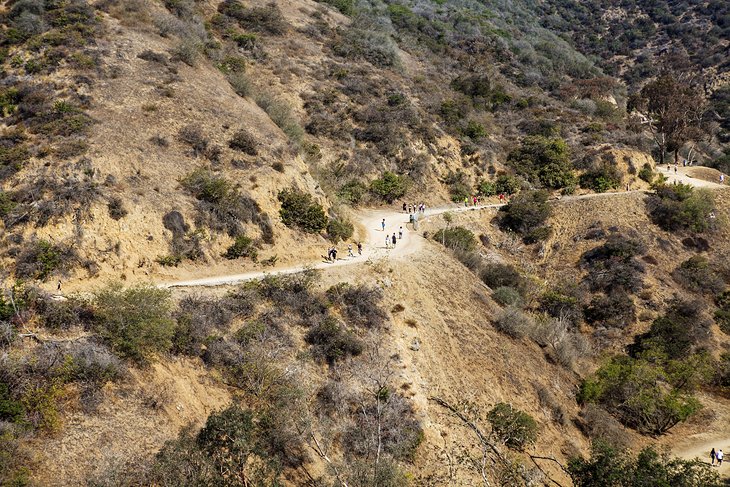
Runyon Canyon Park, Los Angeles
The Runyon Canyon Park is a subconscious gem right in the center of Los Angeles, a city where residents are rarely seen walking. The 130-acre park is just 2 blocks from Hollywood Boulevard. All the same, information technology'southward undiscovered by most tourists. Locals come here to get fresh air, exercise, and walk their dogs.
Runyon Canyon Park offers several dissimilar trails, all with amazing views of the rugged landscape and Los Angeles cityscape. From some vantage points, it'southward possible to see the Pacific Bounding main and Catalina Island in the distance. Tourists should also check out Griffith Park for other excellent hiking trails within the urban center of Los Angeles.
Location: 2000 Due north Fuller Ave, Los Angeles, California
Adaptation: Where to Stay in Los Angeles: All-time Areas & Hotels
- Read More:
- Top-Rated Tourist Attractions in Los Angeles
nine. Solstice Canyon Trail in Malibu
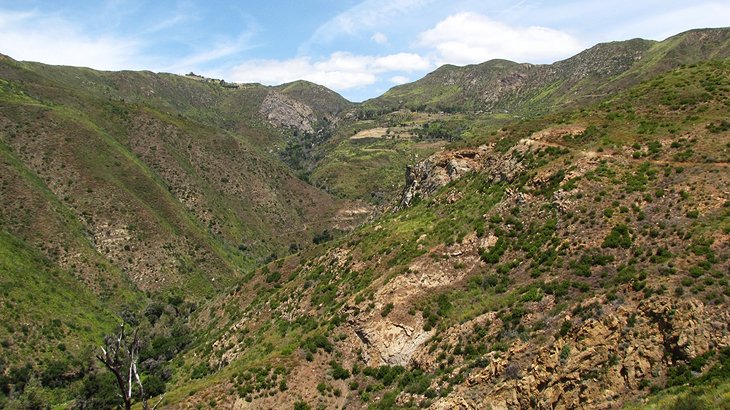
Solstice Canyon Trail in Malibu
Well-nigh the coast in Malibu, a neat day trip from Los Angeles, the Solstice Canyon Trail is a identify of serene dazzler. The trail is part of the Santa Monica Mountains National Recreation Area, which was historically an important site for the native Chumash people.
The Solstice Canyon Trail is among the nearly pop hiking trails in Southern California, too as one of the best places to visit and admire nature in the Santa Monica Mountains. This two-mile round-trip hike begins at the parking lot and meanders alongside a creek, through oak groves and coastal shrub. The trail features thrilling views of dramatic canyons, sagebrush-covered mountains, and the deep blue Pacific Ocean.
Because of the trail's location nearly Malibu beaches, it tends to become crowded on weekends. Yet, the Solstice Canyon Trail manages to retain a sense of solitude and is a peaceful escape from the bustling Southern California urban life.
Hiking Tips: Scout out for poison oak, bees, and rattlesnakes. Be sure to wear the right footwear and article of clothing to protect confronting ticks.
Bring drinking h2o or a canteen to fill with water. There is a drinking fountain at the parking lot.
Location: 3455 Solstice Canyon Road, Malibu, California
10. Pomo Canyon to Shell Beach in Sonoma County
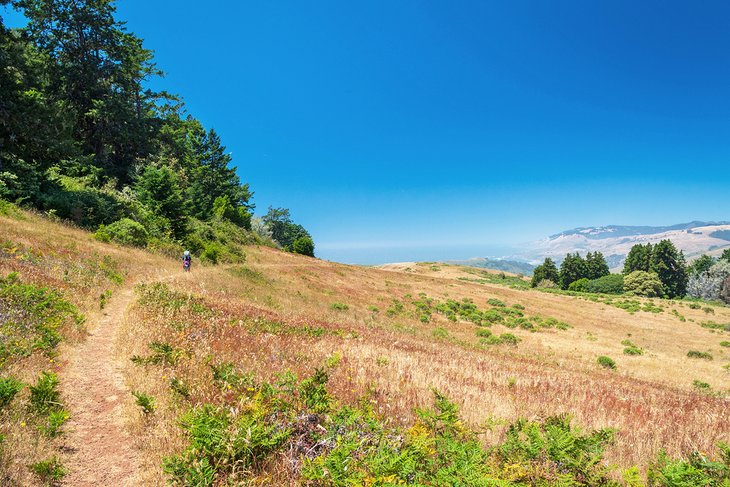
Pomo Canyon to Shell Beach in Sonoma Canton | cgiven / photo modified
Some of California'southward most breathtaking littoral scenery is found in Sonoma County, 75 miles (almost a two-hour drive) from San Francisco. The moderately challenging 3.5-mile Pomo Canyon Trail in the Sonoma Coast Land Park traverses a variety of landscapes. First, the trail climbs through a lush redwood forest, so information technology follows along a wooded ridge with stunning vistas of the Pacific Ocean.
The trail curves around into grasslands with colorful seasonal wildflowers and crosses over several small, picturesque creeks. Towards the end of the hike, the trail joins up with an sometime road that descends down to Highway i.
From the highway, information technology's a brusk walk through the headlands to the sandy shoreline of Shell Beach. Later on spending time at the beach, head back up to the Pomo Coulee trailhead to complete the 7-mile round-trip hike. Alternatively, hikers could do the reverse hike, kickoff at the Shell Embankment parking lot (rather than at the Pomo Canyon Campground).
The surface area north of San Francisco (Marin County and Sonoma County) is known for its cute natural scenery and wonderful hiking trails. It is worth discovering some of the other fabulous hiking trails virtually San Francisco.
11. An Ballsy Hike to the Meridian of Mount Whitney
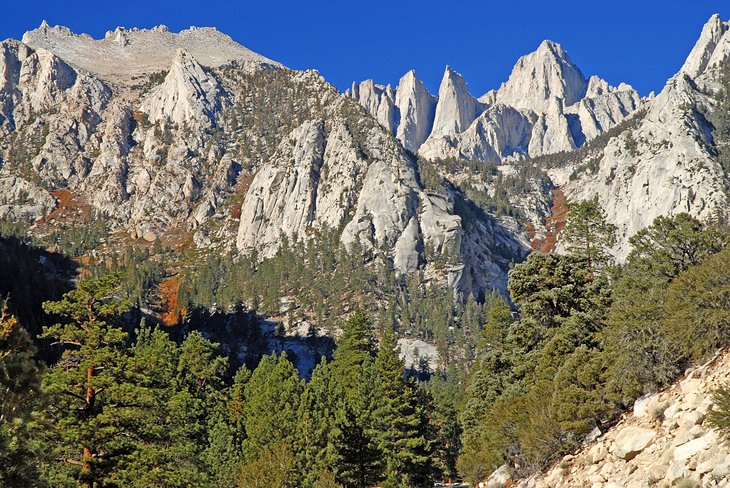
An Ballsy Hike to the Peak of Mount Whitney
Soaring loftier above all the other mountains in California's Sierra Nevada range, Mount Whitney is the highest betoken in the lower 48 states. Mount Whitney is in Sequoia & Kings Canyon National Parks and is the southern endpoint of the John Muir Trail, named after the famous naturalist and abet of wilderness preservation.
This epic hike requires a high level of fettle including altitude workout. Hikers demand to set out earlier sunrise in club to complete the circular-trip to and from the summit in one day.
The most direct trail to the acme of Mount Whitney is the 11-mile (22-mile round-trip) trail from the Mount Whitney Portal, 13 miles west of Alone Pine town. Starting at a trailhead with 8,360-foot elevation, the hike has a challenging half dozen,000-foot gain to the peak at 14,494 feet.
The Mountain Whitney Portal too joins upwardly with the legendary Pacific Crest Trail. This hike is ane of the most physically demanding Pacific Crest Trail twenty-four hour period hikes.
Hikers must start around 5am in the forenoon in gild to complete the 12-60 minutes to 14-hour round-trip hike in daylight. The trail goes deep into the park's wilderness areas and offers sensational views along the way.
Hiking Tips: The Mount Whitney Portal Trail requires an exceptional fitness level and should just be attempted by advanced hikers who are well conditioned. Besides being in acme physical fitness, hikers must be acclimated to the altitude (to avert altitude sickness).
Hiking Conditions by Season: The hike does not crave technical expertise from mid-July to early October. All the same, in jump and early summertime, mountaineering techniques, including ice axes and crampons, are necessary.
Required permits: Hikers and overnight backpackers must obtain a wilderness permit earlier entering the Mount Whitney zone. Wilderness permits are available from visitor centers, ranger stations, and permit stations in Sequoia & Kings Canyon National Parks.
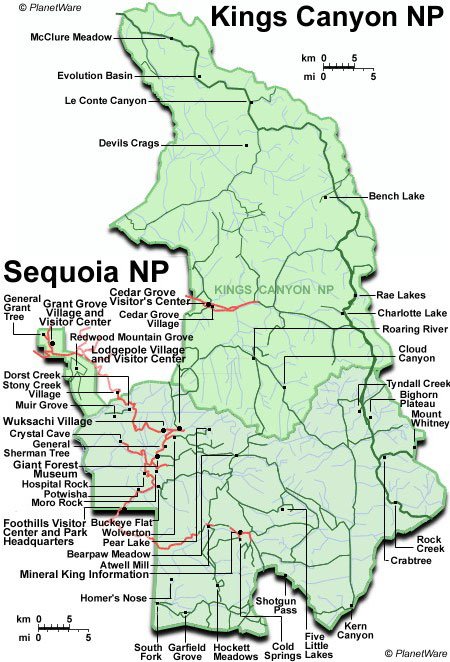
Kings Canyon and Sequoia National Parks Map
12. Lost Coast Trail: An Extreme Outdoor Adventure
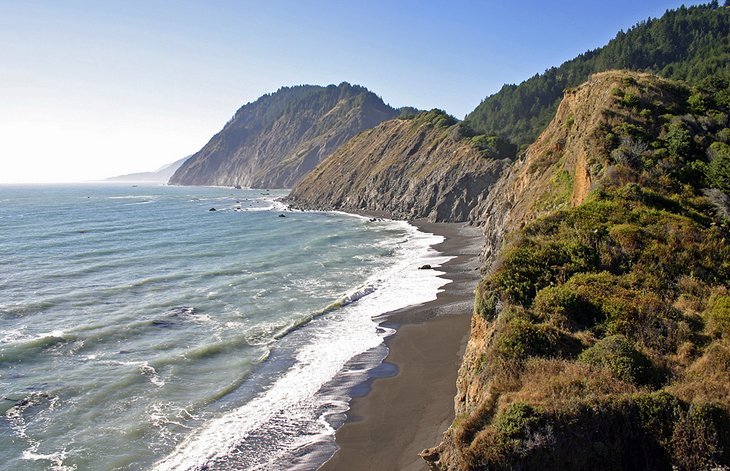
Lost Coast Trail
The Lost Coast Trail offers a rare glimpse of Northern California'south most rugged and remote coastline wilderness. The trail extends for 34 miles alongside the Pacific Ocean in Humboldt County, nestled in aboriginal redwood forests several hours' drive due north of Mendocino.
Adventurous backpackers are the merely hikers seen on the Lost Coast. To hike the Lost Coast Trail requires at least a three- to 4-twenty-four hour period backpacking expedition. Advanced preparation is required before setting out (and conveying a tide nautical chart is recommended). Portions of the trail go submerged and disappear at loftier tide, explaining the trail's name.
The northern part of the Lost Declension Trail is a 25-mile hike from Mattole Beach to Blackness Sands Beach in the Male monarch Range National Conservation Surface area. This function of the trail includes beach hiking, crossing streams and tide pools, and hiking along rocky ocean bluffs. Many vantage points beget panoramic littoral views.
The southern office of the Lost Coast Trail is a 9-mile hike from Hidden Valley to Needle Rock in Sinkyone Wilderness Land Park. This part of the trail traverses meadows, old-growth redwood forests, and chaparral-covered mountain ridges.
The Pacific Ocean forth the Lost Coast has a deep turquoise hue, reminiscent of a tropical island, and the mural of the Lost Coast is sublime. Hikers are nonplussed by well-nigh mythical scenery of canyons, tide pools, waterfalls, dark sand beaches, and meadows blooming with vibrant wildflowers.
The Lost Coast's coves are domicile to sea lions and seals. During winter and early on spring, it'southward possible to spot gray whales on their almanac migration. Throughout the year, Roosevelt elk can be seen roaming the grasslands.
Hiking Tips: This hike is but suitable for avant-garde hikers and requires a challenging backpacking expedition. The trails are steep, and several portions of the trail vanish at high tide. Hikers must know the times when high tide occurs (twice a day) to avoid crossing certain sections of the beach at those times.
Trip Preparation: Advance training is the central to tackling the Lost Coast Trail. You must plan your itinerary alee of fourth dimension and bring a tide chart with you lot.
Permits are required for overnight camping in the King Range National Conservation Surface area. Asking a permit in advance. A limited number of permits are issued on a first-come, offset-served ground. No permits are bachelor for walk-ins. Permits are not required for mean solar day apply.
Shuttle services are available, so that you can complete one leg of the trail without having to exercise the return trip. You can arrange to have a shuttle drop you off and pick you up at a specific fourth dimension.
The King Range National Conservation Area is in a very remote expanse of Humboldt Canton, with long stretches not serviced by gas stations. Be certain to arrive in the area with a full tank of gas.
Camping Training: Campsites are rustic, with no potable h2o or trash cans. Backpackers must bring their own gear, food, and drinking water, also as a filter to purify stream water. Food must be locked in acquit canisters.
Campgrounds are bachelor at King Range National Conservation Area on a first-come, first-served ground. Sinkyone Wilderness State Park has campgrounds available on a outset-come, get-go-served basis; campgrounds must be reserved and paid for.
Know the Rules & Regulations of King Range National Conservation Area and Sinkyone Wilderness State Park before planning an trek to the Lost Declension.
More Related Hiking Articles on PlanetWare.com
What You Need to Know About Hiking in California
Source: https://www.planetware.com/california/top-rated-hiking-trails-in-california-us-ca-94.htm
0 Response to "What You Need to Know About Hiking in California"
Post a Comment